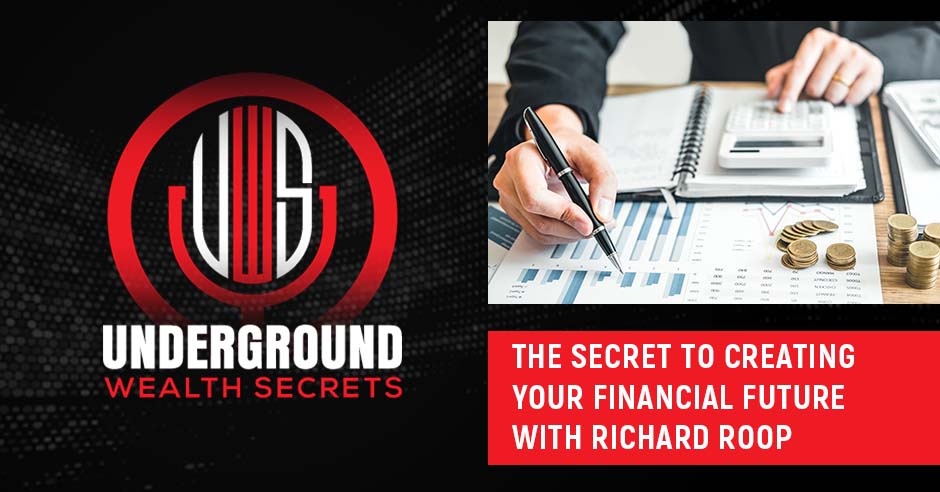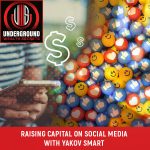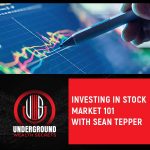The Secret To Creating Your Financial Future With Richard Roop
- Post author By rldiamond
- Post date August 25, 2022
- No Comments on The Secret To Creating Your Financial Future With Richard Roop

Entrepreneurship is the key to financial freedom. You might know that, but are you doing something right now to achieve your goals? Are you committed to it? Listen to Julie Houston as she talks with Richard Roop about the secret to creating your financial future. Richard shares valuable insights on setting goals and figuring out what works for you. He explains what aspects of your business you should focus on and why trying to control everything would not benefit you. Tune in to discover how to generate consistent profits doing what you love and live your preferred lifestyle in the fastest way possible!
—
Watch the episode here
Listen to the podcast here
The Secret To Creating Your Financial Future With Richard Roop
I’m so excited to have you here and I appreciate you taking time out of your busy schedule to meet with me. I know you’re an incredibly busy man. Why don’t you tell our viewers a little bit about who you are and your background?
I’ve been a marketing and advertising guy since 1984 when I first started my first business Richard Roop Marketing and Advertising. I was in the Air Force. The Macintosh came out in 1984 and I got a contract on base for creating flyers, ads, calendars and stuff as a graphic artist. I also created the military discount coupon book, which was cooperative advertising. I made money selling ads to people in Fairbanks, Alaska when I was stationed in Alaska.
I got into entrepreneurship. I started studying success, all the old-time classics, audio tapes, buying programs and reading books. I always say that I have an MBA in direct response marketing, entrepreneurship and creative real estate. MBA stands for Mentors, Books and Audio cassettes. I’ve never been to college or anything like that. When I got out of the Air Force, my wife got stationed in Hawaii. I met her there when I was in the Air Force.
I became an investment broker in 1987 when they had the big market crash, the Black Monday. I was the number one broker because I was telling everybody to short or sell the market. Don’t get into the market. I didn’t like that. I had a guy come in, my former business partner, Dr. Tad James. It’s called NLP.com. We taught neuro-linguistic programming. I created books, tapes and audio cassette programs of his stuff and that’s where I learned marketing.
I built that business. I became a marketing consultant for all types of businesses. I got into real estate in 1996 and bought over 500 houses with none of my money. I’m known as the marketing consultant for real estate entrepreneurs. I work with all types of businesses, virtualpreneurship, entrepreneurship, infopreneurship and that type of thing.
I’ve heard about you and you’ve been through decades with many people in our industry.
It’s wonderful to see all my old buddies from over the decades and all the new up and rising stars. I work with both of them. I collaborate. We go out, go to events and do stuff together. At this time in my life, I like focusing on exactly what I want to do and using my talents the best I can. That could be promoting myself but what I like is helping other people grow and promote their business or themselves. I’m an expert at that. I’ve created hundreds of products. I’ve built multimillion-dollar companies.
You never went to college.

No. That’s why I joined the Air Force because they said they would put me through college. However, I learned entrepreneurship. You don’t get rich working for other people. You got to have your business. There are four levels of entrepreneurship. There’s level one where you’re learning. You’re in school. It’s like the doctor going to medical school. He’s not making any money until he starts cutting people open. Level one is you’re getting ready, setting up but not making any money. A lot of people are sometimes stuck at level one. In my business, we call them seminar grads. They learn but don’t take any action.
Level two is where you make money. That’s marketing and sales. You want to get good at marketing, sales, persuasion, influence, customer service and helping people. Focus on helping people. That’s what to me business is all about. It is getting paid for providing value to the marketplace. It’s like, “What can you do for other people?” In level two, there seems to be some type of limit on how much money you can make without a team and a real business. If you’re doing everything yourself, you’re in a profession. You are self-employed. To make more money, you spend more time.
Usually, people cap out at about $200,000 or $250,000 on their own but if you want to build wealth for the future, you want equity in real estate, businesses or any type of income-producing assets, you should build a business that can operate without you. The way to do that is level three. That’s Systems, Outsourcing, Delegation and Automation. That’s SODA.
A lot of entrepreneurs don’t want to give up that control. I’m always in that. The best thing to do is to notice that you want that to be different. You’re limiting yourself because you’re trying to control everything. You try and do everything yourself. We all go through that and you can pull out of it but I’ve never pulled out of it. I’m a control freak.
It’s like you read my mind. I was like, “That’s me.”
It’s because I work with all types of entrepreneurs and usually, they’re successful. I don’t go out and teach people how to become entrepreneurs. I go out and find people that are looking to try and fix these levels. They’re at level one, school. Level two is marketing and systems. That’s where you get things happening and you can scale that. Level three is scaling. We call that level three business mastery where you build a business that can operate and produce money without you. You don’t have to be there doing everything. You only manage the business. You can have or own multiple businesses but you’re not cooking the fries or doing all the work.
That’s like Robert Kiyosaki’s CASHFLOW Quadrant. You’re either employed or have a job and you’re limited. If you are self-employed, you have that profession but then you have a business where you can build it and produce income without work that you do and then investment. We talked about the secret of creating your financial future. What is the biggest thing that everybody wants? It’s financial freedom.
I have a question. What is your definition of financial freedom?
Create something that would excite you and that you're committed to. You should set it as a goal. Click To TweetThat’s level four, which is financial freedom. You have assets that are producing all of the income that you need to live your preferred lifestyle so you can work whether you want to or not. It’s that simple. I created a program with Coach Willie Hooks who helped me build my coaching program for real estate investors. He’s a great guy and friend. He’s amazing. I created a program with him called Million-Dollar Mindstorming: The Secret of Creating Your Financial Future.
What we did is we had everybody and these were my high-level clients. We spent a weekend at the Cheyenne Mountain Resort in Colorado. We did this only once. We got everybody clear on the definition of financial freedom. What did it mean to them? Not only did we create a definition. You have all these assets that produce all the money you need so you don’t have to work.
You can live your preferred lifestyle. You don’t have to wait to live your preferred lifestyle. You can create your preferred lifestyle now. The biggest thing is deciding what it looks like, that vision. The secret to creating your future, the first step is creating that goal and vision. We had everybody step out 2, 3 or 5 years and take a look at what living their preferred lifestyle and what being financially free meant. We also had them put a dollar number on it.
I have them do an exercise called Billion Dollar Mindstorming where they listed all of the things they wanted to own. Also, all the things they wanted to do and have. We figured out how much that would cost either to rent it, own it or do it. We came up with an income each month to live their preferred lifestyle. We then reversed that back, “How many assets at this rate of return do you need to produce that?
It’s very systematic. Most people say, “I want to be financially free and secure,” but it’s only an idea and a number you’re working on. If you decide, “If I had $5 million producing 10%, that’s $50,000 a month or $500,000 a year.” If that’s what I need, you need $5 million and a way to get 10% or you need 10 million and get 5%. Coming up with that dollar number, if you know why that’s important to you, why you’re going after the money and you focus on that as a goal with a deadline, you’ll then have an organic motivation to do what you know you need to do to hit that goal or outcome.
I call that the Five Step Formula for Success, where number one, you set a goal. It could be a short-term or a long-term goal but the goal has to be SMART. We can talk about that. You then make your plan. Everybody does this backwards, Julie. They try and figure out how they’re going to do something before they’re clear on what they’re doing and why. They’re working on their plan and creating their products or business but they don’t know how much money they’re going to make and when or why they’re doing this. They get busy.
Start with the end in mind and get in touch with why it’s important to you, how it’s going to benefit you and what are the consequences of not achieving that. You want to hit both sides of the motivation there. Once you’re clear and it’s important to you, then create your plan because people don’t set outrageous amazing goals. They limit themselves from their thinking and beliefs about what they’ve done in the past or what they think it requires to get there.
Set those aside and create the perfect vision. Julie, what’s the perfect situation in your life years from now? What would be ideal? I’d have you go out and imagine that. Create that perfect scenario. If it’s unbelievable or too outrageous and you don’t think you could achieve that, what I tell people to do is to notch it down a little bit. I call that the next best thing.

Notch it down to, “That would be amazing and I believe it.” You can change your beliefs and go much higher but you can do that over time. Create something that would excite you and that you’re committed to. You’d love to have it happen and commit to it because if it’s important to you, you should set it as a goal. I don’t think you should set any goals that you’re not committed to.
People beat themselves up all the time with that. They say, “I’m going to do this and this,” and they don’t do it. It’s like a dream and a notion. A goal is a dream with a deadline. For a goal to be SMART, it has to be Specific and Measurable. You have to be able to measure its success. It should be Achievable and Relevant to what’s important to you. Also, Time. It has to have a deadline.
Those are the elements of a SMART goal but people will limit themselves and they don’t have written goals. Sometimes, if you’re promoting an event and there’s a deadline or you’re going on vacation and you know you’re leaving in two weeks, guess how much stuff you get done? It’s because you know. You’re committed.
It works on everything. When you’re working by yourself, who’s holding you accountable? That’s why it’s nice to have a team, a mastermind or an accountability partner to whom you can commit yourself, “I’m going to do this,” and they’ll hold you accountable. That’s why coaching is good if you have a coach that holds you accountable or a mentor.
You want to have a SMART goal. Step number one is to set a goal and make your plan. Once you know what you’re looking for, you can figure out how to do it and get the help you need. You might have all these opportunities that you didn’t even see right in front of you because you’ve never set that goal. By setting the goal, it turns on your reticular activating system and you start becoming aware of these opportunities and these things that would help you.
It’s like you’re creating this. You are creating your future. When I tell you to go out years from now and imagine what’s happening, I’m suggesting that you go out in your mind and create a future memory because your mind doesn’t know the difference between a thought. If you step into your body, look through your eyes and feel what it would be like to achieve that goal, also what would you say, see and hear, if you fully associate it with that type of mental imagery, it feels like it’s now.
It doesn’t know the difference between something in the future or something in the past until you step out of it. What I’m suggesting is you’re creating future memories. When you do that, we have these creating your future techniques where you can notice if there are any obstacles, roadblocks or anything that pops up for you when you set this goal.
Have you ever set a goal and said, “I’m not going to do that because of this, that and the other?” You can decide to change your goal or go knock out that obstacle as part of your plan. Set the goal, make the plan and then lay out the milestones and the tasks and put it into your schedule. Set a goal, make a plan and then work on your plan. Get all of those things that have to happen in your plan into your schedule. Coach Willie Hooks told me, “Don’t think during the week. Look at your schedule. You have all of these things that you’ve already decided in advance that you want to accomplish. Knock them out. It’s stuff you’ve already decided that you want to do.”
Make your plan. Once you know what you're looking for, you can figure out how to do it and you can get the help you need. Click To TweetYou make it sound so simple.
It’s very formulaic and systematic. I teach this. Whenever I sit down with a consulting client or I do a seminar or a program or create a product, I always start with this five-step sales process because it’s like, “What’s the outcome for our meeting, this seminar or this project?” We go through this. Step number three is to work on your plan, execute and take action.
If you set up the first two correctly, that will be easy and natural. Set a goal, make a plan, plan your work and then work on your plan. Step number four is that execution, taking action. Step number five is you’ll get feedback. You won’t be on target all the time but if you stay focused on the result and don’t forget about it, then you can adjust to that feedback along the way. You can hit 90% of your goals if you follow that process and adjust and pivot. Do you know anybody who had to pivot a couple of years ago in their business?
Absolutely.
I tell people that you shouldn’t allow outside forces to dictate what you do because you have the ability to respond and change what you’re doing to adjust. When I set a goal, if I’m going to drive my car to the next city, I might hit some roadblocks, potholes and detours but I’ll get there. It may not be how I planned. That is why the number one secret to creating your financial future is to get clear on your intention behind and setting the goal. I’ll be happy to share some resources with your audience. I have some videos that will walk you right through this process. I have one that helped get you clear with your big why. I share it with all my clients when I start working with them and all that so it’s a great tool.
Thank you.
It’s the secret to creating your future. I published this book for my partner, Dr. Tad James, when I helped build his company from 1988 to 1994 when I lived in Hawaii. That’s how I became a marketing expert because I was studying the marketing gurus like Dan Kennedy and these gurus. I taught all the other gurus and I’m one of those marketing gurus. I create little marketing gurus.
I helped him create that product. I published his book, The Secret of Creating Your Future. We had a two-day seminar that we did. We created a home study and I got an infomercial with some celebrities and everybody. We sold 35,000 of these home study courses on TV with infomercials but as a very powerful program. That process is some of this stuff that we’re talking about and a lot of other stuff but the thing that prevents people from achieving their goals is sometimes negative emotions.

We would walk through processes so they could let go of fear, anger, guilt and hurt. These are emotions from the past. Using some of these visualization strategies and NLP strategies, you could quickly let that stuff go and learn from those things. The only reason you don’t let them go is that your mind thinks you haven’t learned from them yet.
In most cases, you’ve already learned. If you ever had things come up, it’s your mind trying to protect you. A lot of times, you’re so much more mature and you don’t realize it. Once you realize it, you become conscious of it and it disappears. I’ve created a program called the Fearless Investor where I interviewed all my clients back in the day to find out what they were afraid of. I got a list of 52 things that people were afraid of.
I put it into seven different categories and I said, “This is how you knock out the fear of success, failure and all the seven different categories of fears.” Fear does protect you so it’s unjustified. One of the easiest, what I call a sledgehammer technique, is if there’s anything that you should be doing that you’re not doing, call it fear and then analyze it. “What’s the worst that can happen if I do this? What are the consequences? What am I going to lose if I don’t?”
If you notice the fear that is holding you back and analyze them, typically they disappear because it’s more of an unconscious response versus a real fear. It’s like, “Why don’t you want to pick up the phone and call that prospect?” They’re afraid of being rejected. That’s one of the categories. The fear of rejection, failure and success.
With most of the clients that you work with, how do you focus on growth and prosperity during uncertain times?
It comes down to being able to be realistic. A couple of years ago, I work with a lot of real estate investors and the real estate market changed a lot. I was telling everybody that with everything that happened with people’s businesses getting shut down, people losing their jobs and all these other things that happen, the ripple effect is going to last a long time.
My mom had a foot jewelry business at Laguna Beach at the Laguna Village for 30 years. It had to shut down because there were a bunch of hand crafters around a restaurant and they had shut down the restaurant. It put her out of business forever. There are a lot of those little stories like these that have a ripple effect. I told everybody a couple of years ago that you got to start preparing. You got to become an entrepreneur. You got to start not relying on the government and an employer, the things that are outside your control.
Take control where you can and those things that you can’t control, don’t worry about it. I have a little graphic that says, “Do you have a problem?” “Yes.” “Can you do anything about it?” “No.” “Don’t worry about it.” It all goes back to, “Don’t worry about it,” whether you have a problem or not or whether you can do something about it or not. If you can do something, you do something. If you can’t, you can’t.
You shouldn't allow outside forces dictate what you do, because you have the ability to respond, adjust and change what you're doing. Click To TweetIt’s like that negative goal setting. You’re envisioning things that you don’t want to have to happen. You want to focus on what you want and what you do want to happen. I told everybody that you need to decide how you’re going to maintain control over your life, decide what you want, pivot a little bit and stuff like that. Going forward, it’s the same thing. Your success can’t be dictated by those outside forces.
If you see a storm coming, go ahead and take shelter but don’t give up if you’re doing something important. It’s what I call accountability. There is a victim loop that people can fall into where they say, “I would be successful except for this.” It’s outside of them. In The Secret of Creating Your Future, we teach people how to be 100% responsible for everything that happens to them, whether it’s true or not. It’s a useful belief because if you take 100% responsibility for all of the results that happen to you, Julie, then you have the ability to adjust, change and respond differently to get different results. You have that response-ability.
You have that ability to respond. People don’t consciously exercise that. Hopefully, after people read this or maybe read this again, start developing a habit of noticing things that they want to change or how they’re reacting and all that because you have this incredible power if you wake up. It’s called consciousness. You wake up and become aware as opposed to going through. Ninety-five percent of our actions are habitual. It’s unconscious. It’s how we’re programmed.
You can change that programming and do it consciously. That’s what we did with The Secret of Creating Your Financial Future. We walked them through those processes so that we can show people how to consciously change whatever they want in their life. In the tough times, if there’s something that you don’t like or something that’s concerned, go ahead and decide how you want it to be different. What’s the ideal situation? What’s the perfect scenario? Make it a SMART goal and then work on it.
When I first learned this when I lived in Hawaii, I did well buying a couple of properties using my VA loan. My first no-money-down property was a $79,000 brand new townhouse overlooking the ocean in Hawaii. This was in ‘87. A year later, my business was doing good. We used my wife, Cindy’s VA and bought another brand new townhome in the same area for $123,000 with no money down. Those were my first two no-money-down properties because I was listening to some of those audios on real estate but I wasn’t having any success at it. I didn’t get into it until ’96.
This was when the Japanese were having a housing bubble. We bought the 1st one and 1 year later, we bought the 2nd one. I rented that first one out for a year. After two years, I sold both of them. I was doing well. The 1st one bought for $79,000 was $179,000. It over doubled in value in two years. The other one I bought for $123,000 was $203,000. If you have any properties that have skyrocketed and if you think it bubbles, this might be a good time to tap into that. I don’t know. It depends.
It’s like, “Hold forever or go ahead, cash out and redeploy the money.” I made more money on those two deals than all the many years of working. I took that money and found a lot where they were building these luxury homes a little further up the hill where we live. It’s a brand new subdivision overlooking this gorge, the ocean and everything. It’s a 4,000-square-foot house. I bought it for $410,000 or something like that.
I put that money down. I borrowed money for that and bought that. The market turned and I finished up my project with Tad. My son was born and I wanted to move to the Mainland to be closer to family, the grandparents and all that because it was a long flight. I was going to be going to the Mainland and I saw that the market was going to go down. I read a book, How to Sell Your Home in Five Days. I put my marketing expertise into the whole process and sold it in nine days. It’s not just running a little classified ad and having a bid process one weekend. I did direct mail and all types of things advertorial.

I had 60 people come to my open house for two days and bid up the price of the house. I said, “It’s going to be sold for the highest reasonable offer.” I said the highest reasonable offer but no homes in my neighborhood had sold for more than $400,000 in the past year. I had been there for 3 or 4 years but I was able to sell it for over 400,000, more than any other using a creative approach. A year later, that house was worth $320,000.
That was a lot of money back then.
Don’t only tend to spend all the money we make? Our goal is to expand with our income. That’s a big lesson that I learned. If I left everybody with one tip and someone asked me for an interview like if you could go back and talk to your previous self, what would you want to have known or done? I would have saved 5% of every big check that I collected. If I got $3,000, I’d put on $150 in savings. If I got a $30,000 check, I’d put $1,500. You won’t miss that 5%. For a $100,000 check, you put $5,000 away. You got $95,000.
If you put 5% of every big check and put that away and never touch it, keep it safe and clear but never spend it, you’ll be financially free faster than you can imagine. If I did that my entire life, imagine that. It can make a big difference. If you have a lot of income and outgo in your life and business, in a couple of years, that can make a big difference. The biggest key is if you need money because you have an emergency, don’t spend it. If you didn’t have it, you’d have to go out and get that money. Find it. Do what you have to do but don’t touch that. That would be a good tip.
How can folks start creating their businesses exactly how they want to? You briefly went over it but is it following the four-step module?
The Five-Step Formula for Success is to set a goal, make a plan, plan your work, work your plan, get feedback and adjust. The first step, setting a goal is where people miss up. They don’t know what they want. They haven’t decided what they want or they’re unfocused. They’re chasing too many tails. You got to decide what’s most important to you in your financial life and personal life. This is your life. This is not a rehearsal. This is it. We’ll have a good time doing what you want.
You can change anything you want. You have to decide what you want to change and if you have a problem, what would it look like if you didn’t have the problem? Focusing on that Law of Attraction and what you want. Set that goal and make it SMART. The biggest challenge is people don’t decide what they want. People are afraid to set a goal because they’re afraid they’re going to fail or they’re not going to do it. They’re going to disappoint themselves again or someone else. That’s because they haven’t spent the time to figure out why they want that particular goal or why it’s important.
I have a buddy who told me and I went through this Billion Dollar Mindstorming process with him. He said he wanted to make $100 million. I asked him. I said, “That’s great. We could walk through that process that I laid out. How many assets? Do you need that much? How much do you need to live your preferred lifestyle?”
You get to decide what's most important to you in your personal life and your financial life. This is your life. This is not rehearsal. Click To TweetFor him, it was a challenge. He said he wanted $100 million because I quizzed them on it. I said, “Could you live your preferred lifestyle with $50 million?” He said, “Yeah. I could do $50 million.” “Why set a goal for $100 million when you’d be as happy with $50 million?” It’s like, “What about $25 million?” You can drill down to something that is going to change your life but is much easier to achieve.
We do a lot of coaching with entrepreneurs. When they set goals that we think are unrealistic, it’s realistic if they’re committed to it and it’s important to them but we look at their history. “I want to make $1 million this year.” “How much did you make last year?” “$30,000.” “Why is making $1 million important?” “I want to do it.” “You made $30,000 last year. What if you made $200,000 this year? Would that change your life? Would that make a difference?” “That would be a huge difference.” Go after the $200,000 first versus the million. Some people push themselves too far and set themselves up for not achieving it.
I want to thank you, Richard, for joining us. You shared an incredible amount of value. Do you have any final words for our viewers?
Thank you. As you can tell, I love to share. You got me talking about something that I’m passionate about, which is personal success and mindset. This is a great way to share it because no one will pay me for this information but it’s great stuff when they hear it.
It’s been an honor having you on and hearing it myself.
Everybody is like, “Show me how to make money.” “It’s marketing and sales but you got to start with that vision.”
Important Links
- UndergroundWealthSecrets.net/Roop
- UndergroundWealthSecrets.net/Giveaway
- UndergroundWealthSecrets.net/FreeCourse
- UndergroundWealthSecrets.net/FacebookPage
- UndergroundWealthSecrets.net/TikTok
- UndergroundWealthSecrets.net/YouTube
About Richard Roop
 One of the countries best kept secrets for training real estate investors. Sharing his free and clear cash strategies, Richard Roop has taught thousands of real estate investors throughout the nation how to generate cash now, cash flow, and cash for later, regardless of what’s happening in the economy, using creative real estate investing techniques.
One of the countries best kept secrets for training real estate investors. Sharing his free and clear cash strategies, Richard Roop has taught thousands of real estate investors throughout the nation how to generate cash now, cash flow, and cash for later, regardless of what’s happening in the economy, using creative real estate investing techniques.
Richard is one of the top direct response marketing ‘gurus’ and consultants dedicated to helping real estate investors generate more leads, negotiate better deals and create more consistent, predictable cash flow each month. He specializes in sharing proven, low cost real estate direct marketing strategies for attracting a steady flow of motivated sellers, as well as real estate business marketing systems for getting investment properties occupied fast. Richard also teaches investors systematic approaches to growing their businesses, leveraging their time and increasing their profitability on each deal.
- Tags assets, automation, delegation, Entrepreneurship, outsourcing, systems







